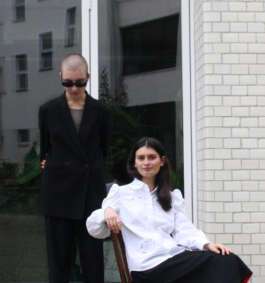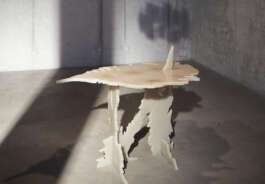



© DERZOST
COLLECTIBLE In-Depth
DERZOST
August 2024
This series, COLLECTIBLE In-Depth, unveils the backstage of contemporary creation. Tackling various topics from personal designer processes to the position of collectible design on the global design market, COLLECTIBLE In-Depth offers different views to suit all tastes. Today we speak with Zlata Holberg and Lorin Meng, co-founders of DERZOST.
C: What tips would you give to a collector who wishes to start collecting contemporary design?
ZH: Think about the essence of the object. Recommendation: in addition to picturesque, consider the content. If there is no discourse inside, then do not buy it. Buy sincerely and follow your heart, think not only about investment.
C: How can collectors contribute to the preservation and promotion of cultural heritage through their acquisitions of collectible design pieces?
ZH: Not just collecting, but showing objects in their natural environment, making them more visible, that is, bringing them into the human field of vision. Giving them to a museum so that they are even more visible. And not only to a museum. You can show them where they are not, not only in big cities, but also in smaller towns, in unexpected places, where people would not go to look. Do not put them in a basement or storage forever. One of the tasks of a collector is responsible ownership of a thing. If the world gives you the opportunity to own such objects, then you need to share this experience. If a collector can openly let people into his home, show objects, talk about them, then more people will learn about them.
C: How does the cultural diversity of your city influence your design choices and the narratives behind your collectible pieces?
ZH: Berlin is a city of science and art. Discourse. The consequences of the war influence the material of the city, the energy of the city. Vital sincerity has a great influence. Berlin is cheap, It changes a little. This opportunity gave artists to expand the discourse due to different nationalities. Berlin is a free city, unlike other cities in Germany. The influence of German culture, Bauhaus, transformational discourse from here. Bauhaus about nationality, utility, at the level of consciousness, the aspiration to equality, affects design. This influenced the city. The city as a creator of progress. Berlin feels like many cities and countries.
C: How do you navigate the balance between embracing technological advancements in your design process while preserving traditional craftsmanship?
ZH: We implement technologies to make production processes more efficient where they are needed, for better perception, communication with people outside the sphere. We do not use artificial intelligence to create a narrative, the execution is less turgid and of higher quality.
Here I remember one exhibition that Lorin visited in Belgrade in the salon of the Museum of Contemporary Art, it was in January 2022.
LM: I can’t remember the name of the artist, but there were computers, phones, TVs carved out of black granite. They had the words “not available in your country”, “if you are reading this, then you are alive and well” or just noise on the screen. In general, the exhibition is probably about the regime, disconnection of communication, and war. But for me, it also showed digital devices in the form of cemetery tombstones. There is no life in digital. These black screens are already a kind of death.
If we talk globally about the use of technology, then as an example, we are for automated warehouses. To draw, it is better to take a brush. From the computer, fine motor skills are lost, which develops the brain. Therefore, maintaining the skill of doing something with your hands is not fraught with mental mortality, unlike using only digital capabilities
C: What do you think collectible design brings compared to other more massively produced pieces?
ZH: It's like a postcard and an original oil painting, on the one hand. At the same time, of course, copying is legitimate and can work very cool - for example, Andy Warhol or IKEA. IKEA, sometimes working with good designers, released a large number of legendary affordable products. Collectible design is cool, we are generally engaged in functional art. But it is expensive and in our case also limited in functionality, and industrial performs another function in itself. Mass production can be both evil and good, it all depends on many factors.
C: What are the challenges in presenting contemporary collectible design?
ZH: I had to take out a loan. Financial. Cultural institutions say that this is business, and business departments say that this is art. Therefore, there is no special support. Instead of creating, you have to solve financial problems. Many investors want to invest in the virtual world instead of the material world in which a person lives every day. In addition, there is a share of people talking about non-commercial art, nothing is clear here at all. Here production costs money, then there are salaries and so on, money = commerce, we do not have a golden antelope and in general the world is not arranged like that now. Such statements are fundamentally surprising, the feeling that the image of a poor suffering artist has not gone away.
LM: I do not want to suffer from poverty, I have enough suffering from experiencing the conceptual component of the works.
C: What dialogue are you bringing this year to COLLECTIBLE?
ZH: Our work is an exploration of perception. As a main topic we took three phenomena: TIME, SIN, MATTER. We work with them under the theme of duality and opening to the viewer the complex field of different appearances through mythological storytellers.

© DERZOST

© DERZOST

© DERZOST
COLLECTIBLE In-Depth
DERZOST
August 2024
This series, COLLECTIBLE In-Depth, unveils the backstage of contemporary creation. Tackling various topics from personal designer processes to the position of collectible design on the global design market, COLLECTIBLE In-Depth offers different views to suit all tastes. Today we speak with Zlata Holberg and Lorin Meng, co-founders of DERZOST.
C: What tips would you give to a collector who wishes to start collecting contemporary design?
ZH: Think about the essence of the object. Recommendation: in addition to picturesque, consider the content. If there is no discourse inside, then do not buy it. Buy sincerely and follow your heart, think not only about investment.
C: How can collectors contribute to the preservation and promotion of cultural heritage through their acquisitions of collectible design pieces?
ZH: Not just collecting, but showing objects in their natural environment, making them more visible, that is, bringing them into the human field of vision. Giving them to a museum so that they are even more visible. And not only to a museum. You can show them where they are not, not only in big cities, but also in smaller towns, in unexpected places, where people would not go to look. Do not put them in a basement or storage forever. One of the tasks of a collector is responsible ownership of a thing. If the world gives you the opportunity to own such objects, then you need to share this experience. If a collector can openly let people into his home, show objects, talk about them, then more people will learn about them.
C: How does the cultural diversity of your city influence your design choices and the narratives behind your collectible pieces?
ZH: Berlin is a city of science and art. Discourse. The consequences of the war influence the material of the city, the energy of the city. Vital sincerity has a great influence. Berlin is cheap, It changes a little. This opportunity gave artists to expand the discourse due to different nationalities. Berlin is a free city, unlike other cities in Germany. The influence of German culture, Bauhaus, transformational discourse from here. Bauhaus about nationality, utility, at the level of consciousness, the aspiration to equality, affects design. This influenced the city. The city as a creator of progress. Berlin feels like many cities and countries.
C: How do you navigate the balance between embracing technological advancements in your design process while preserving traditional craftsmanship?
ZH: We implement technologies to make production processes more efficient where they are needed, for better perception, communication with people outside the sphere. We do not use artificial intelligence to create a narrative, the execution is less turgid and of higher quality.
Here I remember one exhibition that Lorin visited in Belgrade in the salon of the Museum of Contemporary Art, it was in January 2022.
LM: I can’t remember the name of the artist, but there were computers, phones, TVs carved out of black granite. They had the words “not available in your country”, “if you are reading this, then you are alive and well” or just noise on the screen. In general, the exhibition is probably about the regime, disconnection of communication, and war. But for me, it also showed digital devices in the form of cemetery tombstones. There is no life in digital. These black screens are already a kind of death.
If we talk globally about the use of technology, then as an example, we are for automated warehouses. To draw, it is better to take a brush. From the computer, fine motor skills are lost, which develops the brain. Therefore, maintaining the skill of doing something with your hands is not fraught with mental mortality, unlike using only digital capabilities
C: What do you think collectible design brings compared to other more massively produced pieces?
ZH: It's like a postcard and an original oil painting, on the one hand. At the same time, of course, copying is legitimate and can work very cool - for example, Andy Warhol or IKEA. IKEA, sometimes working with good designers, released a large number of legendary affordable products. Collectible design is cool, we are generally engaged in functional art. But it is expensive and in our case also limited in functionality, and industrial performs another function in itself. Mass production can be both evil and good, it all depends on many factors.
C: What are the challenges in presenting contemporary collectible design?
ZH: I had to take out a loan. Financial. Cultural institutions say that this is business, and business departments say that this is art. Therefore, there is no special support. Instead of creating, you have to solve financial problems. Many investors want to invest in the virtual world instead of the material world in which a person lives every day. In addition, there is a share of people talking about non-commercial art, nothing is clear here at all. Here production costs money, then there are salaries and so on, money = commerce, we do not have a golden antelope and in general the world is not arranged like that now. Such statements are fundamentally surprising, the feeling that the image of a poor suffering artist has not gone away.
LM: I do not want to suffer from poverty, I have enough suffering from experiencing the conceptual component of the works.
C: What dialogue are you bringing this year to COLLECTIBLE?
ZH: Our work is an exploration of perception. As a main topic we took three phenomena: TIME, SIN, MATTER. We work with them under the theme of duality and opening to the viewer the complex field of different appearances through mythological storytellers.

© DERZOST

© DERZOST
Contact
info@collectible.design
VIP PORTAL
EXHIBITOR PORTAL
PRIVACY POLICY
© 2025 Collectible
Contact
info@collectible.design
VIP PORTAL
EXHIBITOR PORTAL
PRIVACY POLICY
© 2025 Collectible